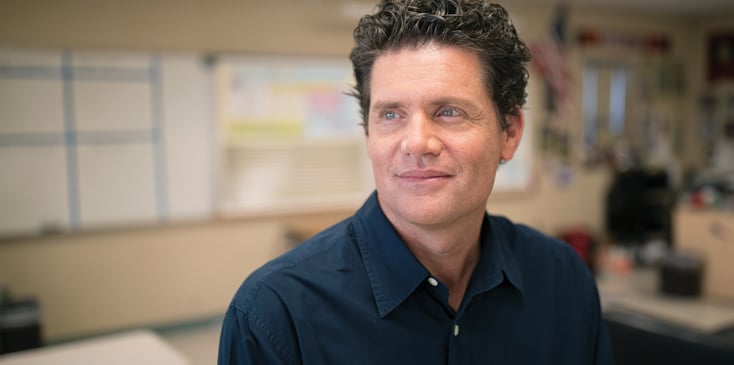
Teachers are among the most highly respected professionals in the U.S. In Gallup’s most recent poll of Americans’ ratings of the honesty and ethical standards of different professions, grade school teachers came in third among the most trusted, ranking behind only nurses and military officers. Among respondents, 66 percent rated the honesty and ethics of grade school teachers as “high” or “very high.” Only 5 percent rated their standards in these areas as “low” or “very low.”
And yet, research shows that school districts across the U.S. struggle to fill their classrooms with qualified educators, a national teacher shortage that is affecting every state in the country. If teachers inspire, engage, and earn the respect of their students, and are highly trusted by the majority of Americans, why is it so hard to find qualified candidates to fill classrooms?
To ensure a quality education for the millions of students in the U.S. in the coming years, school districts, government officials, and other leaders need to examine what can be done to increase the number of people pursuing a degree in education. Just as important, we need to create conditions that will keep these educators in the field once they are fully trained.
Is There a Teacher Shortage?

When it comes to difficulties in staffing classrooms, no region in the U.S. is immune. According to data released by the U.S. Department of Education, the teacher shortage affected every state in the country during the 2017-2018 school year.
Though each district struggles to fill different subjects, several areas appear to be consistently understaffed across the board. According to numbers released by the U.S. Department of Education for the 2016-2017 school year, the top five subjects experiencing a shortage — and the number of states affected — are math (48), special education (46), science (43), foreign language (41), and English as a second language (31).
While no state is exempt from this challenge, some have been hit particularly hard. When examining the teacher shortage, California is a state that instantly comes to mind. The California Teachers Association reported that the Golden State ranks at the bottom of the U.S. for student-to-teacher ratio, and would require an additional 100,000 teachers merely to reach the national average.
The Learning Policy Institute’s report “Addressing California’s Growing Teacher Shortage: 2017 Update,” found that three-quarters of the state’s districts were experiencing teacher shortages, with the vast majority reporting the shortages were only becoming worse. The report further revealed that the number of students enrolled in teacher preparation programs was near “historic lows.”
California’s neighbor to the east is another state struggling with the shortage. The Washington Post reported that in Arizona, more than 20 percent of teaching roles were still unfilled four months into the school year, and in urban school systems, an estimated 20 percent to 30 percent of educators are not even hired until the school year is already in progress.
The Development of the Teacher Shortage
Whether it’s an elementary school position or a high school algebra role, the fact remains that in every state, there are not enough educators to go around. While there are many reasons behind this deficit, a few of the primary contributors include the retirement of the baby-boom generation, declining interest in an education career among students, and high rates of teacher turnover.
The Baby Boomers Reach Retirement
In 2009, the National Commission on Teaching & America’s Future warned that the nation would lose as many as half of its teachers over the next 10 years as baby boomers began to retire. Now a decade later, it is clear those fears were well-founded.
“The pending retirement of the baby boomers has been a concern for a long time,” says Judy Mantle, dean of the Sanford College of Education at National University. “With the economic downturn a few years back, many teachers put off retirement, but we’re at a point where they’ve begun to retire. That alone has been a major factor, I think, in leading to the nature of the shortages we’re seeing now.”
Interest in Careers in Education on the Decline
Despite high demand, college students today are increasingly unlikely to pursue an education degree. In the 1970-1971 school year, 176,307 bachelor’s degrees in education were conferred by postsecondary institutions, according to the National Center for Education Statistics. Over the years, that number steadily declined, reaching 87,217 bachelor’s degree in education by the 2015-2016 school year, less than half the number reported just 45 years prior.
High Turnover Rates Plague Education
The lack of new teachers might not be such a dramatic problem if school districts were more effective in retaining their educators. According to NPR, in the first five years of teaching, almost 50 percent of educators transfer to a new school or leave the teaching profession altogether.
In addition to the instability caused by these constant staffing changes, high turnover rates cost schools billions of dollars. In fact, a 2014 report by the Alliance for Excellent Education found that approximately half a million educators in the U.S. either change schools or careers each year, carrying an estimated price tag of $2.2 billion annually.
Examining the Impact of the Teacher Shortage
In California, Arizona, and every other state across the nation, millions of students need to be educated. The National Center for Education Statistics estimated that about 50.7 million students enrolled in public elementary and secondary schools in fall of 2017, a number that does not account for students in private schools, institutions of higher education, or trade schools.
Many of these pupils end up attending a school where high student-teacher-ratios make it difficult — if not impossible — to obtain the personalized attention they need to excel. According to the National Center for Education Statistics, there were an estimated 3.2 million full-time-equivalent teachers employed in public schools in the fall of 2017, creating a student/teacher ratio of 16.1. In 2007, that ratio was only 15.4.

Research has long suggested that smaller classes can be beneficial to the learning process. For instance, a 2014 study by the National Education Policy Center found that smaller class sizes are typically associated with higher test scores for students, particularly when combined with a qualified teacher. This correlation was especially strong when looking at the lower grades and students who come from disadvantaged backgrounds.
Though the shortage takes a heavy toll on the students in these districts, they are not the only ones affected. Teachers and administrators also have to deal with the logistical stresses of understaffed districts, decreasing job satisfaction and increasing the likelihood that these educators will leave the schools as well. It is a vicious cycle.
As millions of teachers across the country struggle to deliver a high-quality education with limited staff, what can be done to attract and retain the educators that these students deserve?
Solutions for Answering the Teaching Shortage

As the teacher shortage continues to hit districts across the country, Dean Mantle says that it is time to change the narrative surrounding education in the U.S. People are often so overwhelmed by news stories about school shootings, teacher strikes, and classrooms without necessary supplies, that they do not see all the positive aspects of a teaching career and all the qualities of a good teacher.
“I think we need to do any and everything we can at all levels to convey the value of teachers and of the teaching profession at large,” Mantle says. “I believe we need to get the good stories out there in the mainstream, including in the media. We need prospective teachers to hear about the rewards, the benefits, and all these wonderful outcomes from those who’ve been in the teaching profession who can share their stories.”
In addition to celebrating the valuable impact made by educators across the country, school board members, administrators, and other decision-makers need to take a good look at the compensation, work environment, and classroom support offered to prospective and Veteran educators alike.
Compensation
Few teachers would cite financial gain as a top incentive for entering the field of education. That said, financial compensation is still critically important for attracting new teachers and retaining Veteran educators.
If school districts — and states as a whole — want to address the teacher shortage, the financial elements cannot be ignored. In a survey of public school teachers who left the profession, but said they would consider returning, the Learning Policy Institute found that an increase in salary would be “extremely” or “very” important to the ultimate decision of 67 percent of respondents. But the issue is about more than just base salary. Other financial incentives, such as child care assistance and student loan reimbursement, can go a long way in contributing to the financial and overall wellbeing of these teachers.
When teachers are adequately compensated for their work, they feel more valued in the workplace, and experience less stress — both inside and outside of the classroom. However, financial incentives, while very necessary, are far from the only strategy that could make a difference in combating the teacher shortage.
Work environment
To retain teachers, schools need to start by making their campus a place where educators want to work. One of the largest complaints among teachers? The lack of autonomy in their role.
According to the 2017 Educator Quality of Work Life Survey by AFT and BadassTeachers, many educators feel that they have little influence and control on policy decisions that have a direct effect on their classroom. Examples included setting discipline policy, choosing how to spend resources, and making decisions related to measuring performance. If high-level administrators or school boards are making important decisions without teacher input, they may find that staff satisfaction at their school begins to decline.
Relationships among teachers themselves can also create a hostile work environment. Bullying in schools has become a growing concern across the country, with campaigns launched to combat this issue. However, there is another area that does not typically receive as much attention — bullying among teaching staff.
The Educator Quality of Work Life Survey reported that educators experience bullying in the workplace at more than three times the rate of other professionals. The survey results emphasize the great importance of policies that support healthy working relationships among teachers in schools. The survey found that although most schools do have workplace harassment policies that prohibit bullying, fewer offer regular training on the topic.
Issues such as bullying and lack of autonomy can result in an unhealthy work environment for teachers — and that takes a toll. In the Educator Quality of Work Life Survey, the rate at which teachers reported having poor mental health for at least 11 days each month was twice as high as that of the general workforce in the U.S. Additionally, the amount of sleep and level of health outcomes reported by teachers were both lower than recommended.
Workplace wellness initiatives and other programs aimed at emotional, mental, and physical wellbeing can help reduce stress during the workday, helping to prevent teacher burnout and counter the teacher shortage.
Support

While creating a positive work environment is always an important strategy for retaining teachers, the first few years of an educator’s career can be an especially critical time. During these years, teachers are learning to navigate challenges that they’ll face for the rest of their careers — student discipline, school board politics, parent relationships, and more.
Without the proper support and training during this transition, new educators tend to switch schools, or transition to a new career altogether. In fact, according to the Gallup State of America’s Schools Report, between 40 and 50 percent of teachers leave the profession within the first five years.
One solution is a mentorship program.
“Mentorship is vitally important, especially for new teachers,” Mantle says. “Every school has some wonderful teachers who have very practical wisdom about how to help cultivate and evolve yet another good teacher.”
A report supported by the Robert Wood Johnson Foundation found that mentoring and induction programs for new teachers can not only improve retention — they have a positive impact on teacher satisfaction and student academic achievement as well. It is a simple intervention that can pay dividends.
Performance measurement — of both new and seasoned educators — also needs to be considered. The way that both students and teachers are increasingly evaluated by standardized testing and similar methods is of great concern to the education community. The Learning Policy Institute survey found that approximately one-quarter of surveyed public school teachers who left the profession were unhappy with schools’ methods for assessing and overseeing their teaching or curriculum. They reported that these feelings played either an “extremely” or “very” important role in their ultimate decision to leave the profession.
While much can be done to retain teachers, there are also steps that can be taken to recruit more educators. One strategy is to make a career in education more accessible, not by lowering entrance requirements, but by making it easier for students to access the necessary training.
The Learning Policy Institute report recommended creating local pathways into the profession, such as career pathways for high school students, or the “Grow Your Own” initiatives that are helping communities raise up teachers for underperforming schools.
Online degrees are another way to make educational opportunities more accessible to a wide variety of potential educators, including adult learners, students caring for family members, former and current members of the military, and others. By creating options for students to earn an education degree on their terms, at a time pace and location of their choosing, these programs can help eliminate many of the barriers that prevent potential teachers from earning the education they need to enter the classroom.
Your Education Degree with National University
Interested in pursuing an education degree? You are in the right place. National University is a leader in credentialing teachers in California; our alumni network boasts 15 California Teacher of the Year recipients and more than 100 district honorees. As the 10th largest program in the country, our Sanford College of Education educates more teachers than any other institution of higher education in California.
One of our primary goals at Sanford is to make a degree in education accessible to a wide variety of learners, producing the high-quality educators that are so needed to combat the teacher shortage in California and nationwide. That is why we offer both on-campus and online courses to help meet students where they are.
“We’ve always prided ourselves on access to courses and programs by the working adults,” Mantle says. “Having the flexibility to take high-quality, relevant programs is very, very important, and we’ve become more accessible in recent years with the advancement of our online platform of offerings.”

National University’s online degrees make it easier than ever to pursue a career in education. Whatever your personal and professional commitments, you can complete your coursework at the time and location of your choosing, tailoring your academic schedule around a 9 to 5 job, child care, or even military deployments. With a wide variety of degree programs and certificates offered through our intensive one-course-per-month format, we’re committed to making lifelong learning opportunities accessible to a diverse student population.
Education in the U.S. is facing real challenges. But that doesn’t negate the fact that teaching remains one of the most rewarding and respected professions in the country. Whether you’ve always dreamed of a teaching career, or are considering the role for the first time, you have the power to make a difference in the lives of students in your community, equipping them for a lifetime of success.
Want to learn more about how you can pursue a career in education and join National University in addressing the teacher shortage? Request information online here or contact us at [email protected].